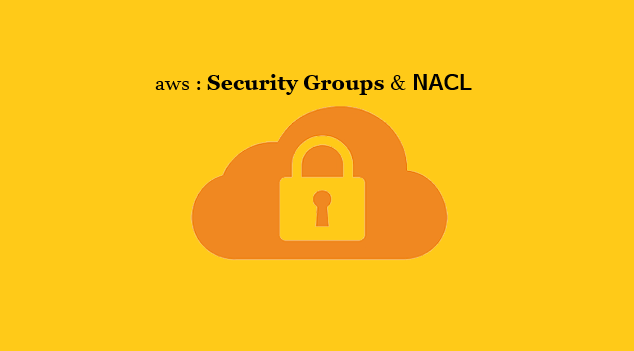Day 5 - Aws Security Groups and NACL
 Arnold Bernard
Arnold Bernard
What are security groups?
In AWS, security groups are a fundamental component of network security. They act as virtual firewalls for your Amazon EC2 instances and control inbound and outbound traffic. Here are the key aspects of security groups:
Filtering Traffic: Security groups control traffic by specifying rules that allow inbound and outbound traffic based on protocols (e.g., TCP, UDP, ICMP) and port numbers. You can define rules to allow specific IP addresses, ranges of IP addresses, or other security groups.
Stateful: Security groups are stateful, meaning if you allow inbound traffic for a particular protocol and port, the corresponding outbound traffic is automatically allowed regardless of outbound rules. AWS tracks the state of connections and ensures that return traffic is allowed.
Default Behavior: When you launch an instance in AWS, it can be associated with a default security group if you don't specify otherwise. By default, this security group allows all outbound traffic and denies all inbound traffic until you add rules explicitly.
Flexible Configuration: You can modify security group rules at any time. Changes take effect immediately and apply to all instances associated with the security group.
Instance Level Security: Each instance in AWS can be associated with one or more security groups. Multiple instances can share the same security group, allowing you to manage security rules at the instance level.
Scope: Security groups apply at the instance level, whereas Network Access Control Lists (NACLs) apply at the subnet level. Security groups are more flexible and easier to manage for controlling access to instances.
In summary, security groups in AWS provide robust, flexible, and easy-to-use firewall rules to control traffic to your instances, ensuring that only necessary and authorized communications are allowed.
What are the advantages of using Security Groups?
Using security groups in AWS offers several advantages:
Ease of Use: Security groups are easy to create, modify, and manage through the AWS Management Console, CLI, or APIs. This simplicity reduces the complexity of managing network security.
Granular Control: You can define specific rules to allow or deny traffic based on protocols, port numbers, and source/destination IP addresses or other security groups. This granular control helps enforce the principle of least privilege, allowing only necessary traffic to your instances.
Dynamic Updates: Changes to security group rules take effect immediately, without the need to restart instances. This flexibility allows you to adapt quickly to changing security requirements.
Stateful Inspection: Security groups are stateful, meaning they automatically allow return traffic related to permitted inbound traffic. This simplifies the configuration and ensures that legitimate responses are not blocked.
Scalability: Security groups scale automatically with your infrastructure. Whether you have one instance or hundreds, security groups can be applied uniformly across all instances, reducing management overhead.
Integration with AWS Services: Security groups seamlessly integrate with various AWS services, such as EC2, RDS, Elastic Load Balancing, and others. This integration ensures consistent security controls across your AWS environment.
Default Deny: By default, security groups deny all inbound traffic and allow all outbound traffic. This default deny stance helps protect your instances from unauthorized access until you explicitly define rules.
Auditing and Compliance: Security groups contribute to your auditing and compliance efforts by providing detailed logs and reports on network traffic. You can monitor and analyze traffic patterns to ensure compliance with organizational policies.
Cost-Effective: There is no additional cost for using security groups in AWS. You only pay for the AWS resources you use (e.g., EC2 instances), making security groups a cost-effective solution for network security.
Overall, security groups play a crucial role in securing your AWS infrastructure by providing robust, scalable, and easy-to-manage network access control.
What are NACL?
Network Access Control Lists (NACLs) are another layer of security in AWS that act as stateless network firewalls for controlling traffic to and from subnets in your Virtual Private Cloud (VPC). Here are the key aspects of NACLs:
Subnet Level Control: NACLs operate at the subnet level within a VPC. Each subnet in a VPC must be associated with a NACL, and a single NACL can be associated with multiple subnets, though each subnet can have only one NACL at a time.
Stateless Filtering: Unlike security groups, NACLs are stateless. This means that if you allow inbound traffic for a specific IP address and port, you must explicitly allow the corresponding outbound traffic. Each rule applies to traffic in one direction only.
Rule Order: NACLs evaluate rules in numbered order, starting with the lowest number. Rules are evaluated until a match is found, and the associated action (allow or deny) is applied. You can insert, delete, and reorder rules as needed.
Default Rules: When you create a new NACL, it comes with a default set of rules that allow all traffic (both inbound and outbound). It's crucial to customize these rules based on your security requirements to restrict access appropriately.
Logging: NACLs can be configured to log traffic that matches specific rules. These logs are stored in Amazon CloudWatch Logs, providing visibility into the traffic flow at the subnet level.
Override Security Groups: While security groups control traffic at the instance level, NACLs provide an additional layer of security at the subnet level. They can be used to further restrict traffic that is allowed into or out of specific subnets, regardless of the instance-level security group rules.
Performance Impact: NACLs can impact performance because they are evaluated before security group rules. If not configured properly, they can inadvertently block legitimate traffic, so careful planning and testing are recommended.
Use Cases: NACLs are typically used in scenarios where you need to control traffic at a broader level, such as between different tiers of an application (e.g., web servers, application servers, databases) within a subnet or to restrict access to certain types of traffic (e.g., block specific IP ranges).
In summary, Network Access Control Lists (NACLs) provide an additional layer of network security in AWS by allowing you to control traffic at the subnet level using stateless filtering rules. They complement security groups and are essential for implementing more granular security policies within your VPC infrastructure.
NACL VS Security Group.
Here is a summary of the main differences between AWS Network Access Control Lists (NACLs) and Security Groups:
● Layer of defense: NACLs operate at the subnet level and control traffic in and out of a VPC, while Security Groups operate at the instance level and control traffic to and from individual EC2 instances.
● Scope of application: NACLs apply to all instances in a subnet, while Security Groups apply to individual instances.
● Statefulness: NACLs are stateless and do not track the state of a connection, while Security Groups are stateful and allow traffic based on the response to previous traffic.
● Default rule: NACLs have a default rule that denies all traffic, while Security Groups have a default rule that allows all traffic.
● Order of rules: NACLs have a numbered list of rules that are applied in order, while Security Groups do not have an order of rules.
● Ability to block traffic: NACLs can block traffic at the subnet level, while Security Groups can only block traffic at the instance level.
● Network performance: NACLs can potentially have a larger impact on network performance because they operate at the subnet level and apply to all instances in the subnet, while Security Groups only operate at the instance level and only apply to individual instances.
Subscribe to my newsletter
Read articles from Arnold Bernard directly inside your inbox. Subscribe to the newsletter, and don't miss out.
Written by
